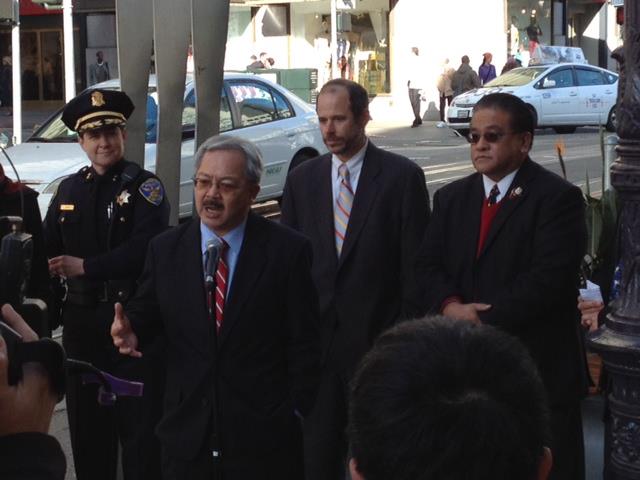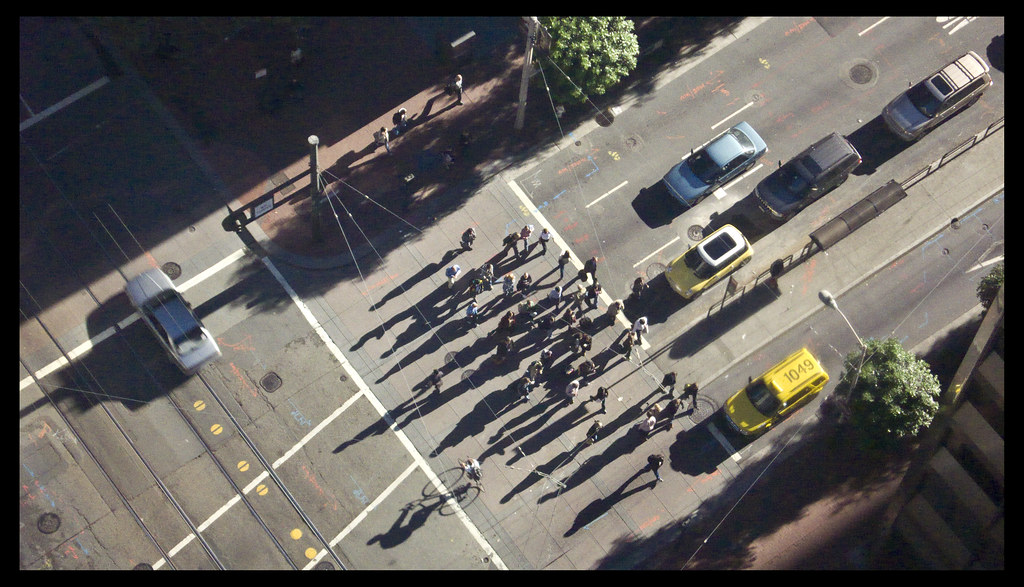While there's no concrete Pedestrian Action Strategy (formerly the "Action Plan") for San Franciscans to read over yet, city officials went ahead and held a press conference today to tell the public the document is coming next month.
Mayor Ed Lee, SFMTA Director of Transportation Ed Reiskin, and other officials gathered on the Powell Street Promenade (a.k.a. the "mega-parklet") to tout the importance of street safety improvements and targeted enforcement efforts to reduce pedestrian injuries by 25 percent by 2016, and 50 percent by 2020, as set out in former Mayor Gavin Newsom’s Executive Directive on Pedestrian Safety.
The press event was unusual in that the officials didn't have much substance to make public at this time. They previewed the pedestrian safety plan but that was about it. Lee said the plan will help "lessen the inequality that exists that we know today between neighborhoods, where people literally fear walking on our streets."
The main piece of actual news to surface today is that SFPD is using a new data-driven enforcement tactic called "Focus on the Five." SFPD Deputy Chief of Special Operations Denise Schmitt said that under this strategy, each police district is targeting enforcement at its top five most dangerous intersections or areas, as well as focusing on the top five most dangerous traffic violations: drivers running red lights, running stop signs, violating pedestrian right-of-way, committing turning violations, and speeding.
Schmitt said police are targeting corridors like Market Street, Van Ness Avenue, and 19th Avenue, where a disproportionately high number of the 800-900 vehicle-pedestrian collisions occur every year. "We've got to bring these incidents down," said Schmitt. "Really, what this is all about is saving lives and letting people enjoy this city."
"The need for action is clear," said Walk SF Executive Director Elizabeth Stampe, who called "Focus on the Five" and the developing Pedestrian Action Strategy "promising" ways to "use data to prevent traffic crimes just as we do to prevent other crimes."

The draft Pedestrian Action Strategy is expected to set out a target for the volume of pedestrian improvements each year, and one big open question is how San Francisco's goal will stack up against similar commitments laid out by New York City and Chicago.
Stampe said implementing physical safety improvements on five miles of dangerous streets per year will "prevent hundreds of injuries and deaths from happening."
"This will mean calming traffic on wide, fast arterials like Geary," said Stampe, in a nod to the street in the background of the press conference. "This will also mean widening sidewalks and adding greening with innovative projects like the Powell Promenade."
While Schmitt and Reiskin said their agencies would take proven measures to make streets safer, they also weren't above some finger-wagging at pedestrians distracted by mobile phones -- despite the absence of data that supports blaming the victim. "I do want to re-emphasize the point: reading that text message is not more important that your getting across the street safely," said Reiskin. "If there's one take-away here, it's that everyone needs to be alert of their surroundings."
Reiskin touted the agency's ongoing efforts to implement safety measures like corner sidewalk bulb-outs, pedestrian countdown signals, road diets, and more visible crosswalks throughout the city.
Speaking from the Powell mega-parklet, which occupies space formerly dedicated to car parking on one of the country's busiest pedestrian streets, Reiskin also praised the SFMTA Board of Directors for taking strong stances on reclaiming space from cars in favor of safer, more livable streets. "The ground that I'm literally standing on here is ground that used to be here for vehicles," he said, "and now it's here for people -- for people to walk, to sit, to enjoy."






